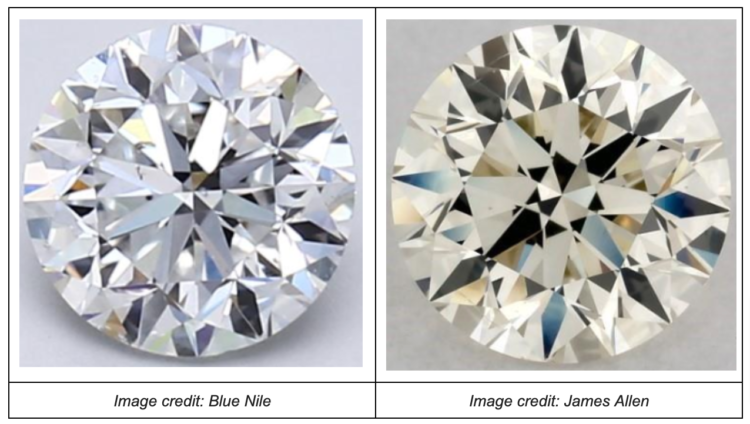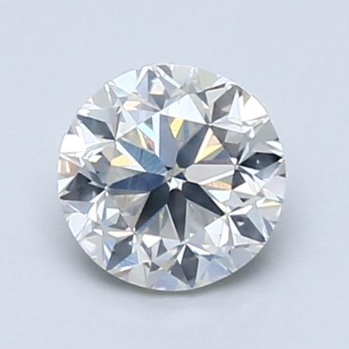This page contains references to diamonds or engagement rings from different companies. Sometimes I do receive a commission when you click on links and buy the products.
Not all diamonds were created equal. When it comes to color, it’s quite common for diamonds to have a slight coloration. During formation the presence of nitrogen in the ground can be responsible for color being present in a diamond, giving it a yellow hue, whereas the brown tinge that can be found in the lower graded diamonds is a result of grains within the body of the diamond, created during formation. It is no fault of the diamond, just a simple act of nature.
We all know that for many centuries diamonds have been one of the most coveted stones on the planet. Of these, it’s the colorless diamonds that have been the most sought after. The rarest of these is the D-graded diamond, which are some of the rarest on the market today. And when it comes to diamonds, rarity means a higher price. A diamond that is colorless offers naturally beautiful fire and sparkle, which can further be enhanced by an excellent or ideal cut.
In this guide, we’ll be exploring what diamond color is, and the diamond color scale, a universal scale used for grading the color of diamonds.
- Diamond Color: A Definition
- What is Grading?
- The GIA Diamond Color Scale
- Why is Diamond Color Grading Important?
- How are Diamond Color Graded?
- Colorless Diamonds
- Near-Colorless Diamonds
- K-Z Graded Diamonds
- Diamond Setting
Diamond Color: A Definition
Overall, diamond color is actually a way of judging how much color is present in a diamond, with heavily colored at one end, and colorless at the other. As we’ve said, having no color is the most sought-after quality regarding color. It’s not the be-all and end-all of a high-quality diamond, and yet it does have a huge impact on the physical appearance of the diamond in question.
Take these two diamonds, one from James Allen and the other from Blue Nile. Both are around 1 carat in size, and SI1 in clarity. But, as you can see, there’s a huge difference in the color quality. The diamond from Blue Nile is D-graded, meaning it is colorless, whereas the one from James Allen is M-graded. The further you go down the diamond color scale, the yellower, and even browner, a diamond will get.

What is Grading?
The diamond color scale starts at D and runs through to Z. This grading system was set up by the Gemological Institute of America (GIA) in the 1950s to provide a uniform grading system that ensures all diamonds are categorized in the same way.
When the GIA first came up with their diamond color scale, there were already several grading systems in place, so to prevent any misinterpretation or confusion about what color a diamond actually was, the GIA’s system was introduced. The chart below shows the GIA diamond grading system and what coloration relates to what grade a diamond is given.

Image Courtesy from The GIA
Most of the high-end diamond suppliers will not stock diamonds below a grade J. This is because once a diamond has been graded and found to have a faint color present, it loses much of its value.
If you’re currently looking for diamonds, color is one characteristic that should never be overlooked. Color differences will make diamonds vary in price greatly (among other influences), so choosing the right color grade is crucial for not only getting a good diamond, but also getting value for money.
The GIA Diamond Color Scale
If you’re wondering why the GIA color grading system starts at D, we can explain. Before the GIA developed the D-Z diamond color scale, a variety of other systems were loosely applied. These included letters of the alphabet (A, B and C, with multiple A’s for the best stones), Arabic (0, 1, 2, 3) and Roman (I, II, III) numerals, and descriptions such as “gem blue” or “blue white.”
The result of all these grading systems was a lot of inconsistency and inaccuracy, which ultimately made it much harder to both buy diamonds and also trust that the diamond you were getting was the actual quality it had been described as. Because the creators of the GIA Color Scale wanted to start fresh, without any association with earlier systems, they chose to start with the letter D—a letter grade normally not associated with top quality. So what are the GIA looking for? This video will explain.
Why is Diamond Color Grading Important?
Color isn’t the be-all and end-all of diamond quality. It’s just one of the all-important 4Cs—Color, Clarity, Cut, and Carat. A fun way of looking at these characteristics when reviewing a diamond is to group them into positive and negative. So which is which?
- Positive: Cut and Carat—these are positive characteristics that you want to be seen and have attention drawn to.
- Negative: Color and Clarity—these are things you don’t want to notice, as in, the diamond shouldn’t have a color, and it shouldn’t have a noticeably poor clarity.
Color grading is important because it’s a very physical characteristic where you can literally see the difference between a high-quality diamond and a lower-quality one. An easy objective to have going into purchasing a diamond is ‘Don’t buy a yellow diamond’. Yet, finding the right diamond is a little more complex.
Overall, color is an important characteristic because it is arguably the most noticeable part of a diamond. If a diamond has a yellow tinge, many people will notice. However, if a diamond has a lower clarity grade and inclusions, these may not necessarily be noticeable.
How are Diamonds Color Graded?
The GIA and other diamond-grading bodies will always grade under strictly-controlled environmental conditions. The main thing under control is light, as different lighting conditions can affect how a diamond appears. Ultimately, how light interacts with the structure of a diamond is where a diamond gets is fire and sparkle, and so light during grading needs to be controlled and standardised, so that every diamond is judged fairly and consistently.
The lighting the GIA uses simulates daylight, in that it’s the same as true white light emitted by the Sun (which is itself a mixture of multiple different colors of light). This enables true analysis of the stone’s color.
Before grading commences the diamond will be passed through a colorimeter to get a baseline color. However, it is the human eye that actually grades the diamond for certification purposes. Diamonds are graded for their color by a gemologist who will look at them through a 10x magnifier with the pavilion (the base of the diamond) face up against a white background.
They will have their color graded against a master set of diamonds of a known color. The diamond will be graded by a minimum of two people to ensure consistency within color grades before being given an overall grade for certification purposes. It’s quite possible to have a diamond that is in-between colors due to the subtle differences between the color gradients. In this scenario, the color of the diamond will be graded lower rather than on the higher grade scale.
Colorless Diamonds
Colorless diamonds are graded between D–F and are often described as being ‘icy white’. The lack of color in them enables them to be viewed as white rather than true colorless. Diamonds that are D and E graded are exceptionally rare and as a result command a high price. An F diamond will have a very tiny amount of undetectable color.

D-graded diamonds are the most sought after because their visual appeal is the highest of all diamonds. This 1.214 ct D IF A CUT ABOVE® Hearts and Arrows diamond from Whiteflash is a fantastic example. Image credit: Whiteflash
Near-Colorless Diamonds
Near colorless diamonds are graded from G to J. These diamonds will show a small amount of color when viewed upon a white background. To the untrained naked eye, the color difference will barely be noticeable when viewed from the table (face up).

This 0.70-Carat Round Cut Diamond from Blue Nile is a great example of an I-graded diamond. Diamonds that are lower on the color scale are the perfect choices for items such as earrings, where viewers won’t be looking at them incredibly closely. Image credit: Blue Nile
What is interesting is that the cut of the diamond can also affect the color to the naked eye, and as a result, an ideal cut diamond will appear whiter than one which has not been cut to the same standard—even though they may be color graded the same.
Diamonds in the near-colorless range can offer excellent value for money as they are not valued as highly as colorless diamonds. It would only be when you placed a colorless and a near-colorless diamond together, face down on a white background that you would see the very subtle color difference.
K–Z graded diamonds
Diamonds that are graded below a J will have noticeable color present in them. K to M diamonds can show a faint yellow tinge to the body while diamonds graded below M will have a quite noticeable yellow hue. Diamond companies such as Whiteflash and James Allen will usually only supply color-graded D-J diamonds as these are the more sought-after and highest-quality diamonds.
Do Diamond Settings Affect Color?
As we mentioned, properly-vetted diamonds are always viewed under strict and consistent lighting conditions against a white background to ensure that the color grade given to the diamond is true. After the diamond has been chosen by the customer, the setting in which it is to be placed can have an effect on how white the diamond appears to the naked eye.
Take, for example, a J-graded diamond that has an ideal cut. J isn’t the highest grading in the diamond color scale, yet if it is placed into a setting made from white metal, such as platinum or white gold, it can look as colorless as an F-grade diamond. This is why near-colorless diamonds can offer great value for money for customers on a tighter budget. The subtlety in the color difference will barely be noticeable so long as the cut and setting complement the diamond.
In summary, to enable you to get the best value for money when shopping for a diamond remember:
- Diamonds are graded from D-Z with D being the highest grade a diamond can be given.
- D-graded diamonds are very rare and as result command an inflated price
- Near-colorless diamonds offer excellent value for money when cut to an ideal standard and set into a white metal.
- The color difference between colorless and near-colorless will not be noticeable to the untrained naked eye.
How to Find the Best Color Diamonds
Ultimately, we would advise you to ensure that your diamond is properly certified by the AGS or GIA to ensure that consistency in grading is achieved. You should always consult a diamond retailing specialist to get the best advice, insight, and expertise surrounding your diamond choice. If you’re curious, explore our retailer reviews section to see what we think of the most well-known diamond retailing groups operating today.
However, if you’re pressed for time, we’ve got four recommendations you can check out today. Our favorite diamond retailers, four companies we trust and admire, are Whiteflash, James Allen, Blue Nile, and Brilliant Earth. They are available to give their expert opinion to you and will ensure that you get the best value for your budget.

Richard Jenkins, The Diamond Guru
Get free assistance from the Diamond Guru today. You’ll be glad you did!
- Secure the best quality diamond for your budget.
- Don’t pay over the odds for your diamond ring.
- Have peace of mind that you didn’t get ripped off.
Have a Question? Contact us now…

